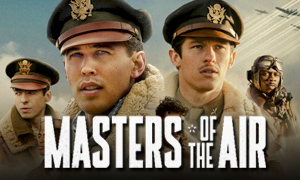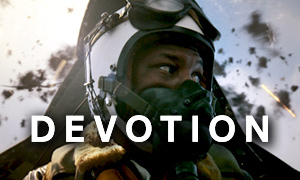The Outpost: History vs. Hollywood
Scott Eastwood
Born: March 21, 1986
Birthplace:
Carmel, California, USA
Staff Sergeant Clint Romesha
Born: August 17, 1981
Birthplace: Lake City, California, USA
Caleb Landry Jones
Born: December 7, 1989
Birthplace:
Garland, Texas, USA
Specialist Ty Carter
Born: January 25, 1980
Birthplace: Spokane, Washington, USA
Orlando Bloom
Born: January 13, 1977
Birthplace:
Canterbury, Kent, England, UK
Captain Benjamin Keating
Born: May 31, 1979
Birthplace: Sanford, Maine, USA
Death: November 26, 2006, Kamdesh, Afghanistan (injuries suffered when vehicle turned over)
Milo Gibson
Born: November 16, 1990
Birthplace:
Australia
Captain Robert Yllescas
Born: October 7, 1977
Birthplace: Guatemala City, Guatemala
Death: December 1, 2008, Bethesda, Montgomery County, Maryland, USA (complications from wounds suffered during IED attack)
Taylor John Smith
Born: May 13, 1995
Birthplace:
Los Angeles, California, USA
First Lieutenant Andrew Bundermann
Born: April 12, 1985
Birthplace: Bovey, Minnesota, USA
Chris Born
Specialist Stephan Mace
Born: April 11, 1988
Birthplace: Virginia, USA
Death: October 3, 2009, FOB Bostick, Kunar Province, Afghanistan (wounds suffered in Battle of Kamdesh)
Jack Kesy
Born: August 27, 1986
Birthplace:
New York City, New York, USA
Sergeant Josh Kirk
Born: July 19, 1979
Birthplace: Thomaston, Maine, USA
Death: October 3, 2009, Outpost Keating, Afghanistan (wounds suffered in Battle of Kamdesh)
Jonathan Yunger
Birthplace:
South Carolina, USA
Sergeant First Class Jonathan Hill
Henry Hughes
Sergeant Brad Larson
Birthplace: Nebraska, USA
When did the Battle of Kamdesh take place?
The battle unfolded on October 3, 2009. It involved a small force of 54 U.S. soldiers (Bravo Troop 3-61), in addition to their Afghan and Latvian allies, at the remote Combat Outpost Keating in northeastern Afghanistan near the town of Kamdesh. The Outpost true story reveals that the soldiers were surrounded by more than 300 Taliban fighters, many of whom were rushing in from Pakistan, which was only 14 miles from COP Keating. The logistical location of the outpost, which was located deep in a valley surrounded by three steep mountains, put the soldiers at an enormous disadvantage. Without adequate support, they were left to fight for their lives against overwhelming odds.
Was life at the outpost so dangerous that they had to put on their gear just to go outside to use the bathroom?
Yes. The movie does a good job of capturing the nerve-racking tension of being posted at Combat Outpost Keating. The high mountains around the camp provided the perfect perches for Taliban snipers to pick off the soldiers.
Why were the soldiers assigned to such a remote and vulnerable outpost?
Jake Tapper, author of the book The Outpost, wondered the same thing when he embarked on his research. Why would the U.S. military put an outpost at the base of three Afghan mountains that were teeming with Taliban fighters who were eager to kill U.S. soldiers? Given its proximity to Pakistan, Combat Outpost Keating was part of a counter-insurgency strategy. The idea was to stop the insurgents' supply lines coming in from Pakistan. COP Keating, which was established in the summer of 2006, was put in the valley for the simple reason that it's where the roads are. The outpost itself also needed to be accessible by road since most of the helicopters were being used in Iraq and were unavailable.
While conducting The Outpost fact check, it quickly became evident that due to its vulnerability, the remote outpost was a strategic blunder. The camp was not well-fortified, its valley location was nearly impossible to defend, treacherous roads and ambushes made it difficult to resupply, air support was at least a half-hour away, and it lacked sufficient resources and numbers to take on a surge of Taliban fighters. A large boulder also forced the landing zone to be placed on the other side of a river, separated from the outpost.
To learn more about Combat Outpost Keating and how it was recreated for the movie, watch our video The Outpost: History vs. Hollywood embedded below. For our latest videos, subscribe to our YouTube channel.
Is The Outpost based on a book?
Yes. The movie is based on the 2012 nonfiction book The Outpost: An Untold Story of American Valor by CNN's Jake Tapper. It was adapted for the screen by Eric Johnson and Paul Tamasy (Patriots Day and The Fighter).
Is Benjamin Keating's death portrayed accurately in the movie?
For the most part, yes. However, Army 1st Lt. Benjamin Keating's death actually happened three years earlier, in 2006, not 2009. In real life, Keating had served with the 3/71 CAV, not the 3/61 CAV (the unit he's part of in The Outpost movie). Clint Romesha and Ty Carter, portrayed by Scott Eastwood and Caleb Landry Jones, were not present when Benjamin Keating died. Keating's death, while mostly historically accurate, is pushed up in the film as a way to condense the storyline.
Knowing the LMTV armored supply vehicle was too heavy for the road in Kamdesh, Keating volunteered against protocol to drive the truck, choosing to risk his own life instead of the lives of the men serving underneath him. As seen in the movie, the road in Kamdesh collapsed underneath the truck, throwing Keating from the vehicle as it rolled over a cliff, sending both himself and the truck down toward the Landay-Sin River. In the process, the truck rolled over him and ended up almost fully submerged in the river. Keating landed between two rocks nearly 150 feet down the cliffside, next to the river. His wounds were severe and while he was initially in and out of consciousness, he died before they could get him back to the outpost. In the movie, he dies almost immediately after landing at the bottom of the cliff.
Unlike the movie, The Outpost true story reveals that Keating was not alone in the truck. Staff Sergeant Vernon Tiller, the most senior mechanic, was in the passenger's seat when it went over the cliff. Tiller was also thrown from the truck but his injuries weren't nearly as severe.
Keating's November 26, 2006 death deeply affected his platoon, who wanted to honor his sacrifice and his selfless care for them. The outpost was renamed Camp Keating in December 2006 (not in 2009).
Why wasn't COP Keating closed if it was too vulnerable?
The military had planned to relocate the outpost in August 2009, but the resources needed for such a move were tied up elsewhere. The brigade was busy guarding another village, and numerous other resources had been consumed looking for Bowe Bergdahl, a U.S. soldier who was held captive by the Taliban after he deserted his post on June 30, 2009. The military's failure to close Combat Outpost Keating earlier likely contributed to the Battle of Kamdesh, which resulted in eight U.S. soldiers losing their lives, while 27 others were left wounded. Four U.S. Army officers were reprimanded for "inadequate measures taken by the chain of command." -The New Yorker
How often was the camp attacked by Taliban insurgents?
"On average, we'd get hit three to four times a week," says Sgt. Clint Romesha, portrayed by Scott Eastwood in the film. While this is indeed alarmingly frequent, the movie makes it seem like the attacks are happening daily. -CBS Sunday Morning
Did a dog at the outpost really bite a village elder?
Not exactly, but in researching The Outpost's historical accuracy, we learned that a similar incident happened the year prior, in 2008, involving more than just one dog. In the movie, a dog that some of the soldiers at the outpost are taking care of bites a visiting Kamdesh village elder. The elder considers this to be a bad omen and demands that there be retribution. Captain Sylvanius Broward (Kwame Patterson), whom the men refer to as "Broward the Coward," shoots the dog to appease the elder and calm the situation. Sylvanius Broward in the movie is a fictional name for a real captain, Mel Porter. In real life, there is no record of Porter shooting a dog.
According to Jake Tapper's book, two real-life incidents inspired the scene in the movie. The first didn't take place at the camp. It took place while First Lieutenant Kaine Meshkin (not in the film) was leading a patrol to Observation Post Fritsche. Several of the dogs that hung around the camp were with them, one of which supposedly bit an old woman working in a field. To make amends with the woman and her family, Meshkin agreed to shoot a shaggy brown dog named Franklin.
The second incident happened in 2008 at Observation Post Fritsche. A dog named Cali growled at the eldest son of an Afghan Security Guard, who would often come to the post with his father. The growling soon escalated into outright hostility, which deeply frightened the boy. To avoid damaging the trust they had established with the Afghans, Cali and another semi-hostile dog named Willie Pete were shot by Staff Sergeant Ian Boone and another soldier.
Was Captain Robert J. Yllescas killed when a remotely detonated IED went off on a bridge?
Yllescas' death happened when he was serving with the 6/4 CAV in 2008. As with Captain Benjamin Keating, the movie pushes both of their deaths to 2009 and fictionally depicts both men as being part of the 3/61 CAV (3rd Squadron, 61st Cavalry Regiment).
Like Milo Gibson's character in The Outpost movie, the real Captain Yllescas was deliberately targeted by a radio-controlled IED as he crossed a walking bridge over a river that was less than 400 meters from COP Keating. The film shows the explosion sending his severely wounded body hurtling into the river, where he is presumed dead. In real life, the explosion ravaged his body, sending him flying through the air and down onto the helicopter landing area, where he was lying face up. His legs were shredded, his hands were severely damaged, and his head had been impaled into his helmet. When Marine Lieutenant Chris Briley tried to move him, pieces of his body began to fall off. Miraculously, Yllescas clung to life and was airlifted out on a Chinook helicopter. Just over a month later on December 1, 2008, he died back in the States due to complications from his injuries.
While Lt Briley is not in the film, he was psychologically traumatized from witnessing what happened to Yllescas. Like the fictional character Pfc. Zorias Yunger, who witnesses Yllescas' death in the movie, Briley was medevaced out of the camp to receive help.
Did Outpost Keating catch fire during the battle?
Yes. The Outpost real story confirms that rocket-propelled grenades and mortars caused the camp to catch fire. Like in the movie, the quick reaction force (QRF) coming down the mountain to help were shocked by the firey devastation. The camp burned into the night and some of the building walls fell to the ground.
Was the attack well-organized by the Taliban?
Yes. A common misconception is that the Taliban are primitive fighters who lack the necessary skills to be effective in battle. However, author Jake Tapper says that this is entirely untrue. "It is one of the most well-planned and carefully choreographed attacks in the history of the Afghan war," Tapper told NPR. "...whatever you think of their ideology, these are fierce and smart fighters."
Did the Taliban really get inside the camp?
Yes. While exploring the movie's historical accuracy, we confirmed that during the real-life Battle of Kamdesh, Taliban fighters got inside Outpost Keating. This seems to be displayed rather accurately in the movie, at least with regard to how it's described in Tapper's book. The soldiers heard over the radio, "Enemy in the wire — The enemy is inside the camp." Insurgents had breached the camp in several locations, including at the main entrance, near the latrine area, and on the eastern side. It's true that some of the Taliban fighters casually strolled through the camp, believing they had won. View Video of Taliban Fighters in the Camp. Like in the film, Sgt. Clint Romesha rallied his fellow soldiers by telling them, "We're taking this bitch back."
Did the United States' Afghan allies flee the outpost during the battle?
Yes. The true story confirms that the Afghan National Army soldiers, who were fighting alongside the U.S. troops, either fled the outpost after the attack began or hid in cowardice. U.S. soldiers reported that none of the Afghan defenders held their positions. Some who fled even handed their weapons to Taliban fighters. -The Outpost book
How many U.S. soldiers lost their lives during the Battle of Kamdesh?
Of the 53 U.S. soldiers who fought in the Battle of Kamdesh at Outpost Keating, 45 survived, 8 lost their lives, and 27 were wounded. An additional 4 Afghan allied fighters also died. For their heroism, 2 Medals of Honor, 9 Silver Stars and 21 Bronze Stars were awarded. The Distinguished Flying Cross was given to 7 aviators who assisted in defending the base.
The Medals of Honor were awarded to Staff Sgt. Clint Romesha (Scott Eastwood in the movie) and Specialist Ty Carter (Caleb Landry Jones). Romesha led a five-man group that was able to secure the outpost and eliminate a Taliban machine gun. Carter, who was seen as a runt and picked on by the others, found himself pinned down in a Humvee. He left the vehicle to rescue a wounded soldier, obtain a field radio, and fetch ammo. The Battle of Kamdesh is regarded as one of the bloodiest battles of the Afghan War. When the fighting ended, an estimated 150 Taliban fighters were killed.
What happened to Combat Outpost Keating after the Battle of Kamdesh?
The Outpost real story confirms that COP Keating was evacuated two days after the battle. The soldiers left so quickly that they didn't take all of the ammunition. As a result, the depot was looted by the Taliban. Several days after the battle, U.S. aircraft bombed the location in an effort to destroy any munitions that remained. In the end, as part of an effort by General Stanley McChrystal, the top commander in Afghanistan, such remote outposts were closed so that more troops could be used to protect civilians in populated areas.
Where was The Outpost movie shot?
The movie was filmed in 2018 on a set created at the base of a mountain in Bulgaria, not far from the city of Sofia. The entire Outpost Keating was recreated. The other two mountains that surrounded the actual outpost were inserted with CGI. The veterans who served as technical advisors on the film said that the set was eerily similar to the real outpost, which no longer exists.
Were any of the real-life soldiers advisors on the set of The Outpost movie?
Several of the surviving soldiers were technical advisors on the film, including Medal of Honor recipient Ty Carter, who is played by Caleb Landry Jones. Daniel Rodriguez, who took part in the real-life Battle of Kamdesh, portrays himself in the movie. Other veterans also acted in the movie, including Henry Hughes. Some of the soldiers who were at the battle are interviewed by the book's author, Jake Tapper, during the closing credits. Director Rod Lurie is himself a West Point graduate and an Army veteran.
Overall, how accurate is The Outpost?
Despite some condensing with regard to the timeline and a fictional character or two (Pfc. Zorias Yunger), most of what unfolds in the movie is largely accurate. Much of this is the result of the real-life Battle of Kamdesh veterans who were involved in the film, both as technical advisors and actors. Even some of the dialogue is taken word for word from real life. This includes Scott Eastwood's character, Staff Sergeant Clinton Romesha, telling the men, "We're taking this bitch back," after the camp is partially overrun by Taliban fighters. In the end, we gave The Outpost movie a Historical Accuracy Score of 8.5/10.







